#villoresi
Text

Reptile - an other version
2 notes
·
View notes
Text

Carlo Felice Trossi, Senor Rovere, Giovanni Lurani and Gigi Villoresi - Maserati 4CM Scuderia Ambrosiana - Crystal Palace 1937. - source Nuno Parente.
64 notes
·
View notes
Text
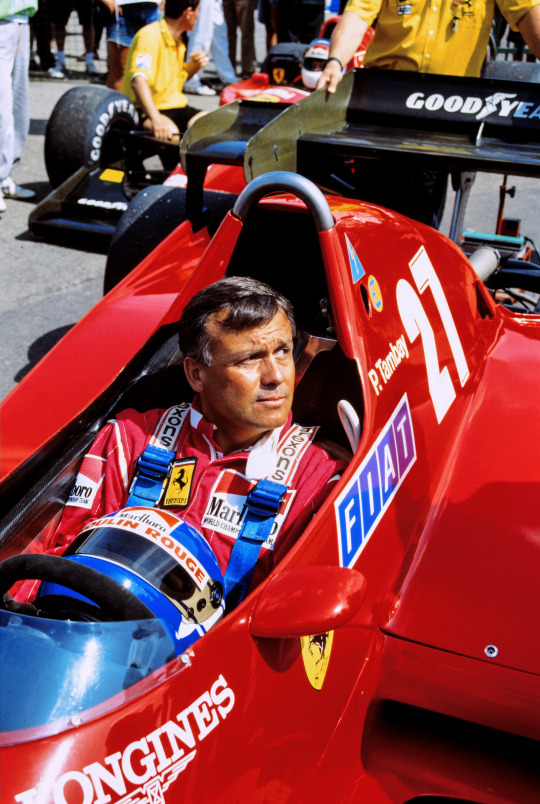
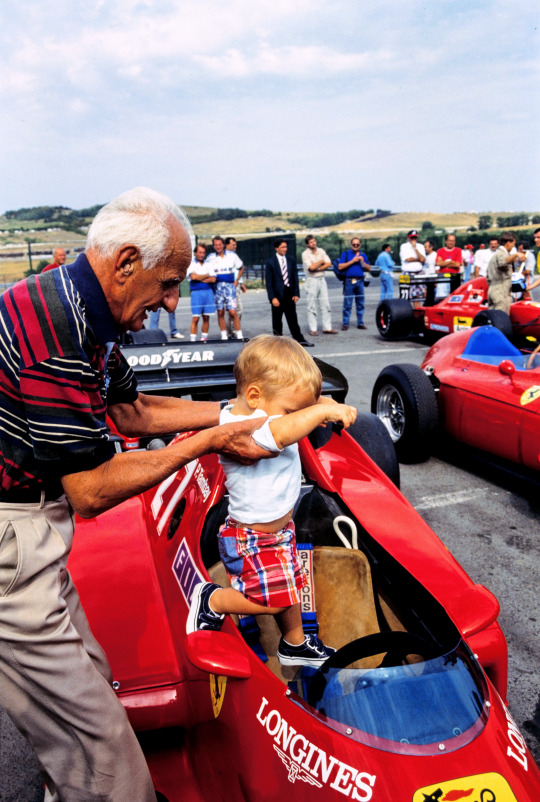

HUNGARY, 1992 — At the celebration for Scuderia Ferrari's 500th race in Formula One, 2x race winner Patrick Tambay suits up for the Ferrari 126C3 he drove in the 1983 season. Luigi Villoresi, one of Ferrari's first drivers since the inception of Formula One, lifts Patrick's son, Adrien, into the cockpit of his father's 1983 Ferrari 123C3. (Photo by Ercole Colombo)
#f1#scuderia ferrari#patrick tambay#luigi villoresi#adrien tambay#la famiglia#ferrari history#patrick passed away last year#gigi passed in 1997...five years after this photo#adrien is a racing driver#he's raced in gp3 gt categories and dtm#still is a fe test driver and works with canal as an f1 consultant!#anyways. ferrari generations....#*ph#*m#*ferrari#1992#hungarian gp 1992#1990s#save#stories#ph: ercole colombo#one of my all time favorite photographers fr#you can just see the resemblance between patrick and adrien#he has such an eye for human moments#when it comes to ferrari <3#anyways isn't it crazy that ferrari reached twice that amount of grand prix in less than 30 years?
28 notes
·
View notes
Text

18 notes
·
View notes
Text
Swiss GP 1950: grand prix #4 in Formula 1 history
When racing in Switzerland still was a thing, Bremgarten was the place where the fourth round of 1950 season happened, on 4th June, but could be considered the third somehow, as in Indianapolis none of the usual teams or drivers entered the race. Alfa Romeo took the top-3 in qualifying with Juan Manuel Fangio, Nino Farina and Luigi Fagioli, followed by Ferrari cars of Luigi Villoresi and Alberto Ascari. Some Talbot-Lago and Maserati were well ahead of a third Ferrari, driven by Raymond Sommer.
All the three Ferraris were forced to retired due to technical reasons, with Ascari the first one, after attempting at the beginning to fight with the Alfas and ending up at some point in third behind Fangio and Farina but ahead of Fagioli. Fangio, at the beginning in the lead and later in second place behind team-mate Farina, was forced to retire too and Alfa Romeo managed to take "just" a 1/2 finish with Farina and Fagioli. Talbot-Lago took a podium with third place from Louis Rosier, while Prince Bira and Felice Bonetto, both Maserati drivers, took the last two scoring positions, fourth and fifth.
#1950's f1#f1 1950#swiss gp#nino farina#luigi fagioli#louis rosier#prince bira#felice bonetto#juan manuel fangio#alberto ascari#luigi villoresi#raymond sommer#alfa romeo#ferrari#maserati#classic f1#retro f1#vintage f1
2 notes
·
View notes
Text
The 1948 Circuito del Garda
Here is the grid for the Grand Prix field for the Lake Garda race at the town of Salò not far north from Brescia which took place on October 24, 1948. It was the first such race at Garda since 1927. On pole in car n. 6, a supercharged Ferrari 125C, is Giuseppe “Nino” Farina while next to him is Ferrari customer Bruno Sterzi with his Ferrari, probably a more normal 166F2 with the single camshaft…

View On WordPress
2 notes
·
View notes
Photo

Ascari, Serafini, Villoresi, Enzo Ferrari
2 notes
·
View notes
Text





Moodboard: Teint de Neige, Lorenzo Villoresi
1 note
·
View note
Text

Angel-A
Spot
1 note
·
View note
Text

La Ferrari 553 Squalo Ferrari 554 2.5 L4 N°38 de Mike Hawthorn - Scuderia Ferrari & la Lancia D50 Lancia DS50 2.5 V8 N°36 de Luigi Villoresi - Scuderia Lancia - Grand Prix d'Espagne - Pedralbes 1954. - source F1 Old and New.
45 notes
·
View notes
Note
Prince Keith, what perfume do you wear?
I personally enjoy Uomo by Lorenzo Villoresi. It's a fragrance for both women and men, so I find it a perfect balance of masculine and subtle.
Some men's cologne can be rather hard on the nose, in my opinion...
It's got some citrus, spice, and herbal notes in it, which I really like. And the scent reminds me of Jade when I'm away.
...
I like Eau Sauvage Extreme 2010 by Dior. It's more masculine than His, but it ain't gross. I ain't tryin' ta smell like a locker room.
It actually smells pretty similar, but mine's just a little more "woody" smellin'.
Whatever that means...
Tags: @mxrmaid-poet @bubblesthegreat3 @rou-luxe @5mary5 @welp-back-on-my-bs @keithsandwich @lostsnowflake3 @a11-mynames-r-taken @sh0jun
Source
16 notes
·
View notes
Photo

ab. 1946-1950 Portrait of pianist Vera Franceschi (photo by Manlio Villoresi)
(Museo di Roma)
199 notes
·
View notes
Text
Belgian GP 1950: Grand Prix #5 in Formula 1 history
In a only 14 cars grid, on 18 June 1950, three Alfa Romeo were starting from the first three positions as usual. Poleman was Nino Farina, followed by team-mates Juan Manuel Fangio and Luigi Fagioli, with Fangio who took the lead in the first stages of the race, to stay in the lead except at the moment in which he had a pitstop - all the Alfa stopped at some point.
Farina was second until he suffered some technical issues and dropped to fourth in the closing stages of the grand prix and Fagioli was promoted to p2. The last step of the podium went to Louis Rosier, Talbot-Lago driver, who already finished on the podium in the previous Swiss GP. It was the last time he was on a podium in Formula 1.
Ferrari, which entered with two cars driven by Alberto Ascari and Luigi Villoresi, ended up in p5 and p6, with Ascari the only of the two in the points as only the first five finishers scored points back in the days. They were ahead of the others finishers Talbot-Lago, the French team being hugely represented on the grid with half of the cars.
#1950's f1#f1 1950#belgian gp#alfa romeo#ferrari#talbot lago#nino farina#juan manuel fangio#luigi fagioli#alberto ascari#luigi villoresi#louis rosier#classic f1#retro f1#vintage f1
1 note
·
View note
Text
The Italian Mob
Before the July 14, 1951 British Grand Prix at Silverstone where the modern Formula 1 had begun with the 1950 British Grand Prix here are three of the top Italian drivers, from the left, Alberto Ascari, Luigi Villoresi and Giuseppe “Nino” Farina. Farina was driving for the Alfa Romeo team in an Alfetta 159 while Ascari and Villoresi would have the increasingly competitive Ferrari 375F1s. The…
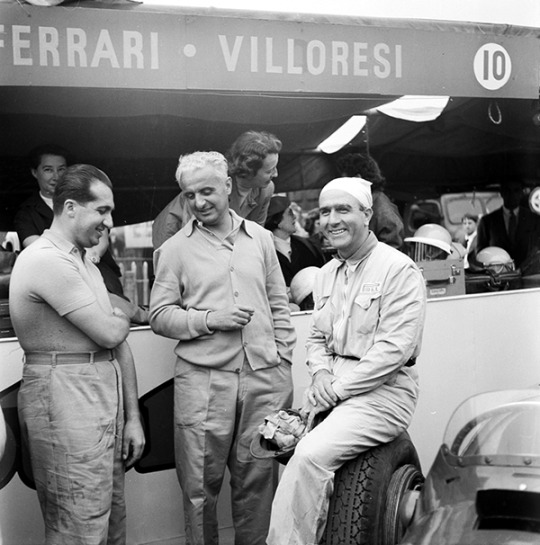
View On WordPress
#Alberto Ascari#Alfa Romeo#British Grand Prix#Ferrari#Froilan Gonzalez#klemcoll#Luigi Villoresi#Nino Farina#Silverstone
2 notes
·
View notes
Text
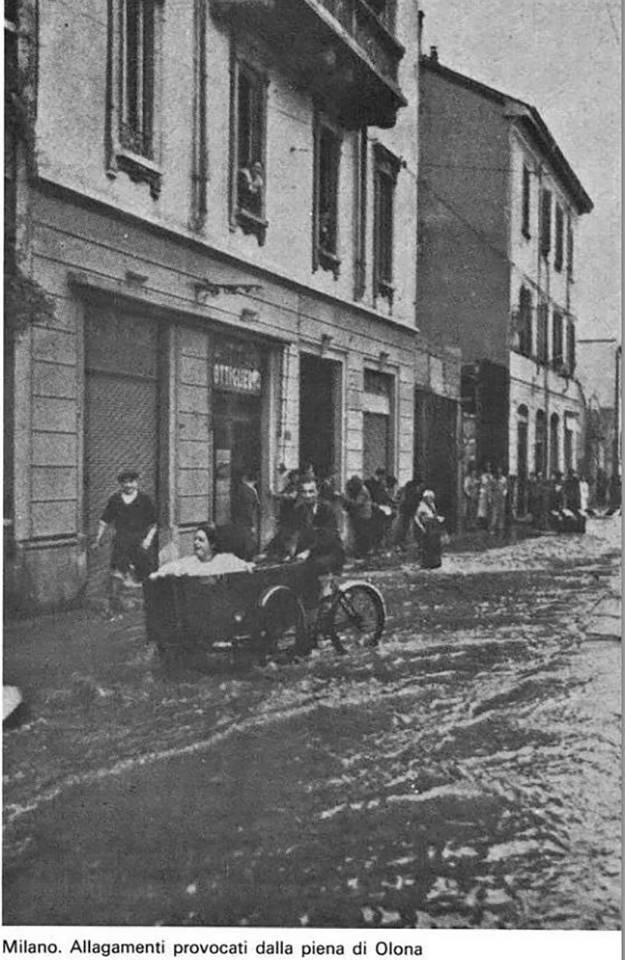
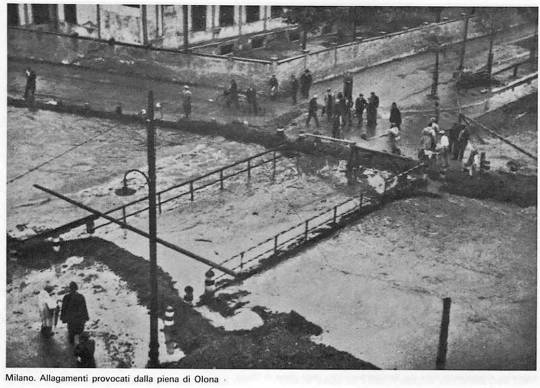

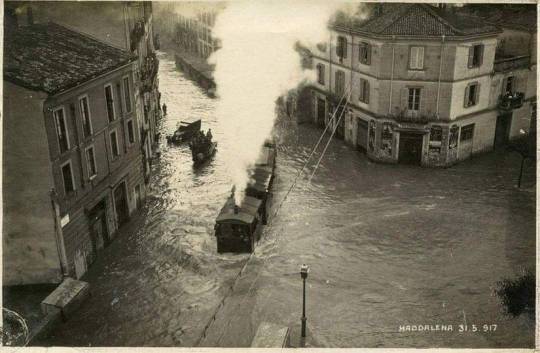
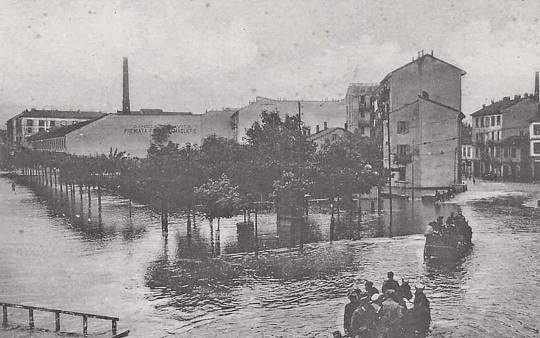
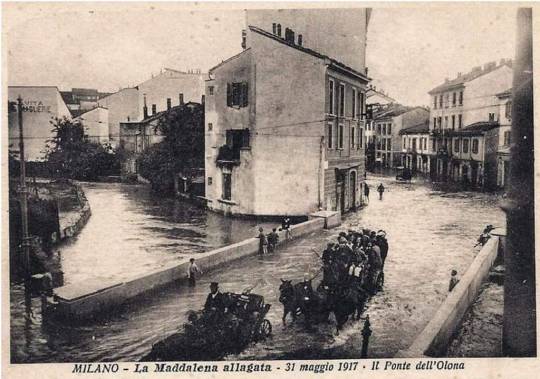
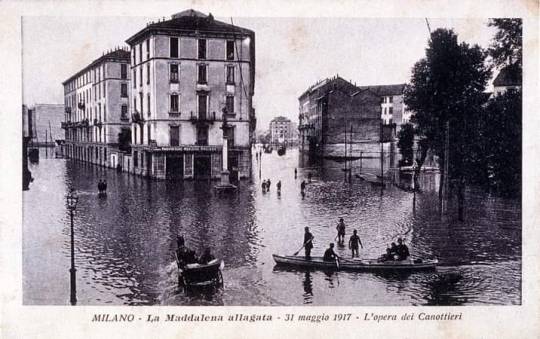
"Mai successo un fatto simile!"
"Mai visto un disastro come quest'ultima alluvione!"
"Cambiamento Climatico!"
"Le stagioni non sono più quelle di una volta!"
Voci del popolino ignorante milanese, riportate con estrema soddisfazione dai TG, quotidiani, politici di sinistra, verdacci, ribadite da Sor Piccozza e da Farfallino Amoroso (Tozzi e Mercalli).
Invece:
Milano, 31 maggio 1917.
Il 30 maggio, in una Milano spettrale, abitata solo da donne, bambini e anziani, iniziò a piovere a metà pomeriggio, mentre forti temporali avevano già interessato la Brianza e la fascia Prealpina.
Negli ultimi giorni del maggio 1917 l’Italia era piegata dalla Grande Guerra; era in pieno svolgimento la terrificante carneficina della Decima Battaglia dell’Isonzo, in cui il generale Cadorna mandò al massacro 400.000 soldati italiani contro le trincee e le mitragliatrici austro-ungariche. I morti italiani furono 36.000, i feriti e i mutilati oltre 130.000 e 26.000 i fanti catturati dal nemico. Dopo un mese di scontri il fronte era rimasto praticamente invariato.
I Savoia avevano imposto la censura più totale agli organi di stampa, le notizie, quindi, filtravano a fatica.
I fiumi Seveso, Olona e Lambro erano tutti ingrossati, piovve tutta notte e all’alba Milano si svegliò come se fosse Venezia.
Tutti i corsi d’acqua erano esondati e i danni più rilevanti avvennero nei quartieri dove correva l’Olona, lungo la zona ovest della città. Anche le zone di Porta Garibaldi e Porta Nuova erano sommerse, così come il Ticinese, dove era esondata addirittura la Darsena.
Le chiamate di aiuto ai pompieri furono centinaia già poche ore dopo il tramonto e continuarono tutta notte, con cantine e androni dei palazzi sommersi in alcuni punti anche da un metro d’acqua.
Il torrente Merlata, che allora correva in superficie, esondò e lo stesso accadde per la roggia Poveretto, le acque invasero il Cimitero Maggiore di Musocco, allagando gli ossari con quasi tre metri di acqua. L’onda di piena dei due torrenti si unì poi a quella del non distante Olona e insieme raggiunsero il quartiere della Maddalena, oggi piazza De Angeli, sommergendo anche le zone vicine di corso Vercelli e del borgo di San Pietro in Sala, oggi piazza Wagner.
I pompieri montarono delle passerelle in legno sopraelevate per far camminare i milanesi, esattamente come a Venezia, ma ben presto anche quelle vennero sommerse da altre ondate di piena dell’Olona.
Vennero sospesi tutti i Gamba de Legn, i tram a vapore extraurbani, che da Milano si dirigevano verso l’area metropolitana a nord e a ovest.
Il Comune decise di far trasferire tutte le bare in attesa di inumazione lontano dal Cimitero Maggiore, per timore che venissero prese dalle acque e portate via. Il cimitero venne poi chiuso, totalmente sommerso da più di un metro di acqua. L’ultima volta era accaduto nel 1893, quando le acque dell’Olona superarono addirittura i due metri di altezza a Musocco e Garegnano.
Diversi stabilimenti e laboratori subirono ingenti danni.
Altri danni notevoli furono arrecati dal Seveso, soprattutto alle porte di Milano. A Palazzolo di Paderno Dugnano crollò un ponte sul Canale Villoresi, alla congiunzione col Seveso; l’onda di piena fu talmente forte da causare l’annegamento di 16 persone. A Milano i danni maggiori furono causati nel quartiere di Ponte Seveso, all’Isola Garibaldi, a Niguarda, a Prato Centenaro e al Mirabello, tutti sommersi da oltre un metro e mezzo di acqua.
A Niguarda crollò un palazzo, fortunatamente tutti gli abitanti riuscirono a fuggire pochi minuti prima del crollo. Il Villaggio dei Giornalisti fu totalmente allagato ed evacuato.
Poco dopo l’alba tutte le linee tranviarie che dal centro correvano verso nord e ovest vennero sospese.
I quotidiani, sottoposti a censura, minimizzarono l’accaduto, nonostante danni ingentissimi, mezza città sott’acqua, 16 morti, collegamenti sospesi e le acque che si ritirarono completamente solo due giorni dopo. Nessuna notizia venne riportata dopo il primo di giugno.
Le foto vennero scattate nel pomeriggio del 31 maggio, quando le acque si erano ormai quasi completamente ritirate. In una foto si vede il Gamba de Legn per Magenta, bloccato dalle acque in via Marghera all’angolo con via Sacco.
(Grazie a Francesco Liuzzi e a “Milano Sparita”)
11 notes
·
View notes
Text

got lorenzo villoresi Donna in an old splash bottle that came in an odd little leather coffin.. a gorgeous rose.. and watched nekromantik for the first time.. u know how i feel about these edgy movies so i knew it wasn’t going to be a love but i was pleasantly surprised.. incredible music, one of the best scores in a movie i’ve seen in a long time.. but i’ve decided probably the ideal way to view nekromantik would be in the worst quality possible with no subtitles so u don’t understand what’s going on and it feels like nightmare smut phantasmagoria.. ohh to have seen it on a bootleg vhs in the 90s..




anyways it wants to be girls and corpses mag so bad 🙄



23 notes
·
View notes